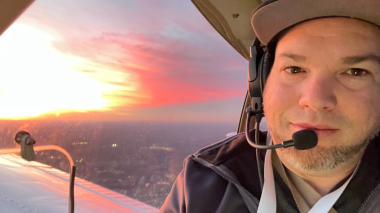They’re the oncology appointments that patients most look forward to. Amid appointments for radiation and chemotherapy, for scans and follow-ups, are two much easier ones: oncology massage and healing touch. But don’t confuse these with spa treatments: Oncology massage and healing touch offer powerful clinical benefits to people coping with cancer.
“After going through three lumpectomies and the double mastectomy and the chemo and radiation, my body was stressed,” says Marina Riggio, a breast cancer patient at Atrium Health Levine Cancer institute. “[Oncology massage] can really relax your body and your mind. It can really help bring you back to a sense of normalcy and return your range of motion.”
Healing touch and oncology massage are part of integrative oncology at Levine Cancer Institute to help alleviate patients’ pain associated with cancer and cancer treatments. Healing touch involves a light, gentle touch to restore and balance energy, and oncology massage is massage that’s adapted to cancer patients’ unique needs. Practitioners are therapists with specialized oncology training who customize treatments throughout the cancer journey. These practitioners adjust treatments to accommodate for the side effects and pain associated with cancer and cancer treatments, as well as medical devices, such as chemotherapy ports.
Proving the Power of Oncology Massage and Healing Touch
Over the past few years, the supportive oncology team has enjoyed converting doubters of oncology massage and healing touch into devotees.
“I really enjoy when a skeptic goes into an appointment and then comes out a total believer. We’ll hear them say, ‘I don’t know what happened in there, but it was great. I feel like a new person,’” says Susan Yaguda, RN, the manager of integrative oncology at Levine Cancer Institute. “That’s the secret of our sauce: When we can address one symptom or improve one aspect of an experience, it has a ripple effect to positively impact other things.”
Patients who come for oncology massage and healing touch share that they have less pain, less anxiety, and they sleep better, too.
“Oh my gosh, I feel like a whole different person,” Marina says of her oncology massage appointments. “I’ve had spa massages in the past, so I was thinking this would be a form of relaxation. But once I started it, I realized how important it is beyond that. They therapeutically relax the areas that are really stressed [from treatments].”
Marina has a gift certificate for a spa massage, and she plans to give it to a family member because she gets so much more from her oncology massage appointments at Levine Cancer Institute.
Now, the integrative oncology team at Levine Cancer Institute has collected data that support anecdotes from patients like Marina. A recent paper published in the International Journal of Therapeutic Massage and Bodywork, Pain Improvement After Healing Touch and Massage in Breast Cancer: an Observational Retrospective Study, has three authors from Levine Cancer Institute: Danielle Gentile, PhD, a health services researcher, Susan Yaguda, and Chasse Bailey-Dorton, MD, chief, Integrative Oncology at Levine Cancer Institute’s Supportive Oncology Clinic. They compared healing touch and oncology massage as non-pharmacologic pain interventions for people with breast cancer. Of the 407 study participants, 57 percent received healing touch therapy, and about 43 percent received oncology massage. Both groups reported statistically significant reductions in their pain levels.
“Healing touch and oncology massage are safe therapies associated with few side effects,” says Dr. Gentile. “Patients have little to lose by trying it. They may fall asleep, that’s it.”
Increasing Awareness and Availability
Part of the impetus of the study was to increase availability of these services. Currently, most insurance providers do not cover healing touch and oncology massage; philanthropic organizations like 24 Foundation and Sherry Strong help fund access for many patients. Dr. Bailey-Dorton hopes that proving their clinical value may compel insurance providers to re-evaluate their policies toward these services.
“Is there evidence to the benefit of these services? That was our ultimate question behind this study,” says Dr. Bailey-Dorton. “These aren’t covered by insurance, and the only way to get insurance coverage is to show the research outcomes. Now we’ve shown pain relief without adding medications. And we've also learned that pain has a very strong emotional component to it, especially for a woman going through a breast cancer diagnosis. By bringing these services on board, we've been able to address that emotional support of pain, and now we're showing physical outcomes.”
“We hope our outcomes can contribute to the body of evidence to support healing touch and oncology massage as beneficial,” Dr. Gentile says. “We hope that by contributing to that body of evidence that maybe insurance companies will look to our study for evidence, and – in a great world – these would be covered by insurance.”
While the study was limited to breast cancer patients, all three authors believe that the pain relief findings are applicable to those with other types of cancer as well. In addition to pain relief, healing touch and oncology massage have shown improvements in patients’ blood pressure, fatigue, depression, anxiety and nausea. It can also improve sleep and mental clarity. The integrative cancer team can help patients choose between oncology massage and healing touch, depending upon their symptoms and preferences.
Part of Long-term Cancer Survivorship
Oncology massage and healing touch can help patients throughout their cancer journey, from the point of diagnosis through years after treatment ends. Yaguda hopes more patients know that this option is available to them from day one.
“One of the most heartbreaking things we hear is, ‘How come I didn’t know about this when I was first diagnosed or when I was having trouble with treatment?’” Yaguda says. “We can definitely make an impact very holistically and help patients manage those stages.”
As some side effects related to cancer and cancer treatments can last years after treatment ends – even after no evidence of disease remains – the team at Levine Cancer Institute wants patients to consider incorporating oncology massage and healing touch as part of their treatment, as well as long-term survivorship.
“I want to empower people to always be engaged in self-care activities, even beyond the end of their cancer treatments,” Yaguda says. “Whether it’s committing to a massage or healing touch once a month, or whatever they feel will help support them, it’s part of our job to empower patients to continue a healthy journey.”
“We’re not just focused on the cancer and the cancer treatment,” says Dr. Gentile. “We’re focused on helping the entire person.”
Oncology massage, healing touch and consults with Integrative Oncology physicians are available at several Levine Cancer Institute sites throughout the Charlotte area. To learn more about these programs, as well as other integrative oncology programs, at Levine Cancer Institute, please visit Cancer Support Programs on our site or call the Department of Supportive Oncology at 980-442-2500.



